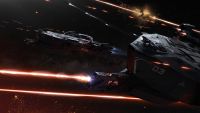- 開始:在2545年,United Planets of Earth(UPE)Weapons Development Bureau(WepDev)確定了Idris飛船的初始規格。這艘護衛艦是在First Tevarin War後,試圖改革Earth's軍事的一系列前瞻性計劃的一部分。這些計劃設想了一個和平時期的United Planets of Earth,其邊界顯著擴大,包括從Tevarin吞併的領土,以及對更遙遠星球的殖民。伊德里斯號的具體要求是開發一艘85米長的輕護艦級飛船,該飛船可以停靠一對巡邏戰鬥機。這些輕護艦的建造成本更高,數量也比現役的艦艇更多,並將被迅速部署,以幫助快速發展的United Empire of Earth(UEE)巡邏使用。新船的主承包商(包括設計和製造)通過無投標合同分配給了Aegis Dynamics,一些組件和支持合同則被分配給較小的、現在已經不存在的公司。
- 原型:在2549年,船的原型在經過三年由外界評論員看來複雜的官僚主義的承諾的開發後開始它的太空試驗。這艘船與最初設想的輕護艦的規格完全不同:它是一艘巨大的護衛艦級飛船,體積是最初提議的幾倍,安裝了一門巨大的軌道炮,並攜帶了一個功能齊全的飛行甲板,能夠支持多種級別的戰鬥機和轟炸機。與評論員相矛盾的是,從提議的輕護艦到護衛艦的轉變對相關人員來說是無關痛癢,並且似乎是自然的。隨着戰後帝國的現狀變得越來越清晰,設計規範被修改了多次。帝國的皇帝梅塞爾結盟規劃者們很快就意識到這個項目對建立他們自己的權力基礎非常重要,他們與宙斯盾和其他承包商密切合作,特別是負責安裝在第一次飛行的艦艇上的軌道炮的Aim-Krug,以擴大設計範圍,為現代戰艦定義一個模型。從原來的輕型護衛艦擴展到護衛艦是一個罕見的決定,它符合所有相關人員的最佳利益。為了強調該項目的重要性,第一艘以在Idris IV獲得的recent victory命名,其已經被神話化為新帝國的基礎元素。[1]

